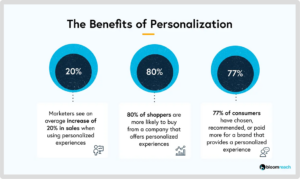Shopify vs. Magento: Choosing the Right E-commerce Platform for SMBs
Feeling overwhelmed by the Shopify vs. Magento dilemma? Our comprehensive comparison breaks down the features, benefits, and considerations, helping SMBs navigate towards the perfect e-commerce platform for their unique needs.
Image credit: (L) Adobe.com; (R) Shopify.com
Choosing the right e-commerce platform is a make-or-break decision.
In one corner, we have the sleek and user-friendly Shopify. On the other, the powerful and customizable Magento. Both pack a punch with impressive features. So which contender best suits your SMB’s unique needs?
| Note: Adobe acquired Magento in 2018, resulting in the enterprise edition now known as Adobe Commerce. Throughout this article, we’ll use “Magento” and “Adobe Commerce” interchangeably. |
Given their excellent reputations and feature-rich offerings, with similar general applications selecting between Adobe Commerce and Shopify can be daunting. Both are industry-leading e-commerce platforms, catering to the diverse needs of SMBs. Our goal is to provide a comprehensive comparison of Shopify and Adobe Commerce, empowering SMB merchants to make informed decisions. Buckle up for an in-depth analysis!
A quick glance at market share numbers puts Shopify in the lead—Shopify powers 2.71% of the top 1 million websites worldwide, while Adobe Commerce trails at 1.05%.
So what gives Shopify this edge, especially for SMBs? In short, Shopify wins because of its intuitive interface and vast app ecosystem making it a knockout for merchants seeking a quick, code-free launch.
But don’t count Magento out just yet. While Magento is best known for its deep customization that is suitable for larger enterprises with dedicated tech resources, can SMBs also benefit from its robust features and scalability? Let’s find out.
Making the Call: Factors to Consider for Your SMB
Let’s break down the key factors to help you make the best call:
🎯 Identify your unique needs: Every SMB is different. Take a deep dive into your specific requirements, budget, and long-term goals. Identify what matters most to you—ease of use, scalability, customization, or cost-effectiveness?
⚖️ Weigh the pros and cons: Shopify and Adobe Commerce both have their strengths. Shopify shines with its user-friendly interface for SMBs, affordable pricing, and robust app ecosystem. Adobe Commerce flexes its muscles in customization and flexibility. Consider which platform aligns best with your priorities.
🔮 Look to the future: As an SMB, your e-commerce journey is just beginning. Think about how your chosen platform will grow with you. SMBs are typically also rapidly growing businesses. Can your chosen e-commerce platform accommodate your future product lines, marketing strategies, and sales channels? Choose a platform that not only fits your current needs but also has room for expansion.
Remember, this decision is all about YOU. Trust your instincts and choose the platform that feels right for your SMB’s unique journey.
Shopify vs Magento At A Glance
A comparative overview of Shopify’s capabilities against Adobe Commerce for SMBs
Shopify and Adobe Commerce both offer robust features for SMBs, but let’s take a closer look at how they stack up:
- 🔌 Effortless plug-and-play: Shopify’s easy setup process for small businesses guides you through building your store step-by-step. The platform’s straightforward interface makes it simple for even the most non-technical entrepreneurs to get their store up and running quickly. With the intuitive theme editor, various customization options, and the ability to add products and set up payment gateways with ease, Shopify streamlines the process of setting up an online store. Adobe Commerce— on account of its promise of a ton of customization options— requires more technical knowledge. In other words, you need a developer on board to reap all those customization benefits and get your site up and running.
- 🔒 Ironclad security: Sleep soundly knowing Shopify’s got your back with built-in fraud analysis, SSL certificates, PCI-DSS compliance, and GDPR adherence. Magento also offers robust security features, but they might require manual setup and configuration. Either way, your data is in good hands. As the top e-commerce platforms, you can expect both Shopify and Magento to treat security with utomost seriousness.
- 💻 No code? No problem!: You don’t need to be a tech wizard to wield Shopify’s power. With user-friendly drag-and-drop tools, pre-designed themes for quick customization, and 6,000+ helpful apps, you can DIY your way to e-commerce success—save those precious funds for other areas of your business. Shopify’s intuitive theme editor with various options makes customization for SMB websites a breeze, ensures responsiveness across devices, including mobile, desktop, tablets and so on, and enables cost-savings for SMBs. Moreover, Shopify’s app ecosystem allows you to extend your store’s functionality without the need for custom development. On Magento, most businesses will need to hire or have an in-house developer set up their website or will heavily depend on the use of extensions. Don’t get us wrong; the store you eventually build on Magento can be stunning, with functionality that shoppers will delight in. You’ll just need sufficient coding knowledge, or a coding team, to get there.
- 🏢 Fits businesses of all sizes: Whether you’re a solopreneur or a growing SMB, Shopify scales with you. In fact, 99.5% of Shopify’s customers are small businesses. You’ll be in good company! Magento is build to help enterprise businesses to thrive. Shopify is built for all businesses. Additional features are available as your business grows, to better support you, so you only need to pay for the features you need when you need them.
- 🔍 Instant online presence: No domain yet? No worries! Shopify includes a subdomain with your subscription, so you can start promoting your brand online right away. Since Magento caters to enterprise businesses, who typically already have a domain name, you would need a domain name on Magento.
- 🚀 Apps that amplify your potential: Both Shopify and Magento have app ecosystems that are a treasure trove for SMBs with easily integrable tools for marketing, advanced customer support for small businesses, shipping, warehousing solutions and more. From dynamic wishlist apps like Swym that allow shoppers to save and organize their favorite products, to personalized marketing campaign tools that encourage repeat visits, there’s an app for every need.
- 📦 Dropshipping without breaking the bank: Eager to try dropshipping? Shopify offers affordable (even free!) options from multiple providers. On Magento, users need to integrate a dropshipping extension that ranges in price from $219 USD to $699 USD.
- 💸 More bang for your buck: With Shopify, you get a lot of value bundled into your subscription—web hosting, subdomains, themes, free drop-shipping options, and many more. Magento’s costs can quickly add up in comparison. While Adobe Commerce’s base version doesn’t have a monthly subscription, the cost to get a site up and running is greater.
- 💳 Sayonara, extra transaction fees!: Unlike some payment providers that nickel-and-dime you, if you use Shopify Payments it doesn’t attract additional transaction fees on any plan. Magento doesn’t charge transaction fees, but you’ll notice incremental fees with the addition of a payment provider. For example, Stripe charges 2.9% and 30¢ per transaction to accept card payments online and 2.7% plus 5¢ to accept in-person payments.
Wrapping Up: Your SMB’s Next Chapter 📕
Whew, we’ve covered a lot of ground! Let’s recap the key takeaways:
✅ Shopify and Magento are both e-commerce heavyweights with distinct advantages
✅ Your SMB’s unique requirements, budget, and aspirations should steer your decision
✅ For most SMBs, Shopify takes the lead with its user-friendly interface for SMBs, affordable pricing, and scalability options for growing businesses
✅ Magento/Adobe Commerce caters to businesses of all sizes prioritizing deep customization, but comes with a higher price tag
For SMBs looking for a quick, cost-effective launch and room to grow, Shopify is the clear champion. Its intuitive tools, app ecosystem, and predictable pricing make it a knockout choice.
However, if your business demands heavy customization and you have the budget and tech resources to support it, Magento/Adobe Commerce may be worth the investment.
Regardless of your platform choice, there’s one app that can propel your SMB to new heights: Swym. This powerful customer engagement tool integrates seamlessly with both Shopify and Magento.
- Swym allows your customers to effortlessly save products for later or add them to wishlists, creating a smoother shopping experience and increasing the likelihood of purchase.
- With Swym’s in-depth analytics, you gain valuable insights into customer preferences and behavior, empowering you to make data-driven decisions and personalize your strategies.
- Swym’s robust feature set, including abandoned cart recovery and personalized marketing campaigns, helps you engage customers at every stage of their journey and boost conversions.
You’re now equipped with the knowledge to make a confident decision for your SMB’s e-commerce journey. Here’s what to do next:
- Evaluate your business needs, budget, and growth objectives
- Choose the platform that aligns best with your priorities
- Integrate Swym to supercharge your customer engagement and conversions
- Launch your store and start selling!
Are you ready to take your SMB to the next level? Choose your platform wisely, harness the power of Swym, and get ready to dominate the e-commerce arena! Your success is our success—sign up today.
People also ask
Which is better for SEO: Shopify or Adobe Commerce?
Shopify is the winner when it comes to SEO optimization for SMB websites. It’s faster, has built-in SEO features, and plenty of apps. Plus, Shopify’s got a handy blog component for search-friendly posts.
Can I combine Magento and Shopify?
Nope! Magento and Shopify are separate platforms. Each can create a fully functional e-commerce site independently.
Can I migrate my existing store from Magento to Shopify?
Absolutely! But be prepared for some technical challenges and data transfer considerations. Consider getting help from experienced developers or migration services.
Do Shopify and Magento support multi-channel selling?
Shopify includes several built-in technologies like multichannel selling, which is only available on Magento by purchasing pricey extensions.
Are there any hidden costs associated with using Shopify or Magento?
While Shopify’s pricing is transparent, additional costs may arise from third-party apps, transaction fees, and custom development. With Magento, hidden costs may include hosting, extensions, and developer expenses.





